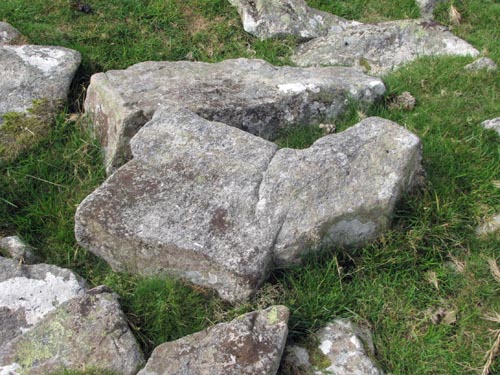| Three Barrows Cross |
 Location: In
clitter near the summit of Three Barrows Location: In
clitter near the summit of Three BarrowsO/S Grid Ref: Due to the importance and sensitive nature of this cross, it has been decided not to publish its exact location. Map location: See above. Purpose: It is thought that this stone is a section of what was originally one of four crosses that marked the boundary of the Manor of Brent. Size: The piece of shaft measures 17½ inches (0.44 metres) long, an average of 15 inches (0.38 metres) wide and 10 inches (0.25 metres) deep. Information: It would appear as though this section of cross is all that remains of the original Three Barrows Cross. It comprises of the head of the cross, with one arm still attached. It is not known what happened to the rest of the cross. The width of the shaft tapers from 16 inches (0.41 metres) at the top down to 14 inches (0.36 metres) at the point immediately above the arm. The length of the remaining arm is 9 inches (0.23 metres), which would have meant that the cross measured about 2 feet 8 inches (0.81 metres) across the arms when it was intact. I must add a note at this stage to say that although this piece does resemble the head and one arm of a cross, it has not been authenticated as such. We are sufficiently satisfied to include it in our website, but it is up to the visitor to make up their own mind as to its authenticity. It is thought that this was the original Hobajohn's Cross, which stood in a line of boundary stones, marking the boundary of the parishes of Ugborough with South Brent and sited a short way to the north of Three Barrows, at Grid Ref: SX65120/63094. However, when Sir William Petre acquired the Manor of Brent he arranged for four crosses to be erected to mark the boundary of his recently acquired lands. It seems that Hobajohn's Cross was removed from its position in the line of boundary stones and set up on the centre cairn of Three Barrows as one of the four markers. The other three crosses were sited at Lower Huntingdon Corner, Western Whittaburrow and Buckland Ford, although the latter is now missing. At some later time this cross was removed from its position on the central cairn and broken up. There seems to be some confusion about the link between the current Hobajohn's Cross and the original one. However, it is clear that they are two separate crosses, with different stones being used for each one. It would be a mistake to think that the modern Hobajohn's cross is positioned in the same spot and is a replacement for the original but, nevertheless, I like the idea of this stone keeping the name of 'Hobajohn's Cross' in current use. It is reported in various Dartmoor publications that this piece of the Three Barrow's Cross keeps disappearing amongst the clitter around the barrows and very occasionally turns up again, only to be lost again for a number of years. It is my thought that this piece of stone is so difficult to identify that it has probably lain in the same place all the time, but only occasionally is it recognised for what it is and reported on. Our thanks go to Bob Noakes for bringing this section of the Three Barrows Cross to our attention. Resin Cross - Grid Reference: SX65023/62605
This resin cross is one of three known similar crosses that have been placed in this general area of the moor during the period of lockdown, but it is not known who is responsible for their appearance or why. As we are unable to discover the reason why these crosses should have been placed in this area the moor, we would be interested in hearing from anyone who might have any further information on them, by email from our link on the home page: http://www.dartmoor-crosses.org.uk/.
|